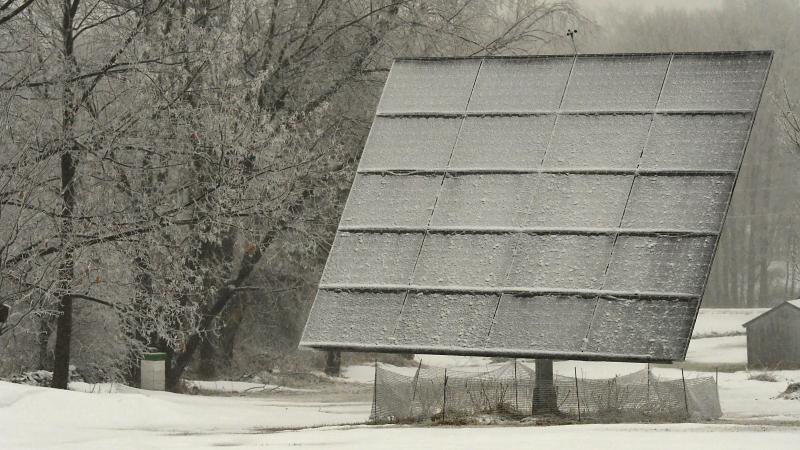U.S. power grid faces higher risk of blackouts during extreme weather, high demand, studies show
The report is the latest in a string of reports over the past year that find the changing mix of electricity generation sources -- specifically the increased reliance on "green" energy -- to the North American grid is threatening the nation's energy security, and making it harder to keep up electricity supply up during high demand periods or weather emergencies.
The top U.S. power grid watchdog warns that more than half of North America and about two-thirds of the United States could face blackouts this winter as a result of growing reliance on renewable sources, the retirement of coal-fired generation plants, and inadequate investment in fuel supply and weatherizing for natural gas-fired electricity generation.
The report is the latest in a string of reports from the North American Electric Reliability Corporation (NERC) over the past year that find the changing mix of electricity generation sources on the North American grid is making it harder for electricity supply to keep up during high demand periods.
NERC is a not-for-profit international regulatory authority whose stated mission is "to assure the effective and efficient reduction of risks to the reliability and security of the grid" and performs long-term and seasonal assessments of the ability of the U.S. and Canadian grids to meet demands throughout the year.
Its "2023-2024 Winter Reliability Assessment" released Wednesday finds that much of North America is at a risk of having insufficient energy supplies during periods of extreme weather, and that the risk is becoming higher. “The growth of intermittent resources, like solar generation, on the distribution system significantly increases load forecasting complexity and uncertainty. Once again, we strongly recommend that operators take the necessary steps to prepare for winter,” said Mark Olson, NERC’s manager of reliability assessments, in a statement about the report.
All the areas of the eastern U.S. and Great Plains, with the exception of Florida, parts of Southeast, and New York are at elevated risk, according to the report. That means there’s a potential for the grids serving those areas to experience blackouts during high demand.
The report explains that during past events of extreme cold, more than 20% of generating capacity is forced offline as a result of increased heating demand and plants not being properly prepared to operate in extreme cold.
Exacerbating that problem, wind and solar energy only produce electricity under the right weather conditions, which don’t always follow demand. To ensure a reliable electricity supply the wind and solar farms have to be backed up by dispatchable power, which are generation resources that provide electricity almost continuously. Those are primarily hydroelectric, which come from dams, nuclear energy, natural gas-fired power plants and coal-fired power plants.
In 2010, nearly 45% of electricity generation came from coal, and just over 24% was from natural gas. As coal plants have been shut down as part of the Biden administration’s climate goals, the amount of electricity from natural gas has increased. In 2022, coal provided approximately 19% of U.S. electricity generation, and natural gas covered 39%.
Wind and solar, which provided less than 3% of electricity to the grid in 2010, grew to nearly 15% in 2022.
Homes also use natural gas for heating. According to the U.S. Energy Information Administration, natural gas provided 42% of residential energy needs in 2021. When cold weather increases home heating demands, there is less natural gas to power electricity plants.
This week, NERC also released its final report on the power outages that affected millions of customers in the eastern half of the U.S. during Christmas 2022 as a result of Winter Storm Elliott. According to the Department of Homeland Security, that storm was responsible for extensive vehicle pileups, and more than 10,000 delayed and canceled flights. Michigan and New York experienced whiteouts and periods of zero-visibility conditions.
During that cold snap, as homes burned more gas to keep warm, supplies of natural gas got strained, the report explains. The natural gas plants had a shortage of fuel, and wind and solar resources weren’t enough to meet demand. Natural gas plants, the report also found, are not properly weatherized to operate during extreme cold conditions, and that leads to some plants being shut down as well.
The findings in the report on Winter Storm Elliott and the Winter Reliability Assessment echo those of NERC’s "2023 Summer Reliability Assessment."
“The natural gas supply and infrastructure is vitally important to electric grid reliability, even as renewable generation satisfies more of our energy needs,” the summer report stated. The summer report was also the first time NERC identified an administration's energy policy as a risk itself to the reliability of the grid.
“There is an undeniable need to increase coordination and collaboration among all policy makers and regulators as well as on the owners and operators,” the report recommended.
The "2022 Long-Term Reliability Assessment" released in December 2022 looked at risks during normal and extreme weather events from 2023 to 2027. At that time, NERC assessed the greatest threats to shortfalls in the West, especially California. The Midwest, Louisiana and Arkansas were areas of high risk. Drought in the West, the report explained, led to concerns about the availability of hydroelectric power, but large amounts of moisture hit the West last winter bringing relief to many drought stricken areas.
The long-term assessment identified the changing mix of electricity resources as a primary cause of potentially dangerous power shortfalls. “Fuel production or transportation disruptions could limit the amount of natural gas or other fuels available for electric generation. Wind, solar, and other variable energy resource (VER) generators are dependent on the weather,” the report noted.
The Biden administration’s climate goals call for all fossil fuel power generation, including natural gas, to be eliminated by 2035. As more areas of the U.S. find themselves without power when the thermometer rises too much or drops too far, there is a growing awareness of the need for dispatchable power.
This week, Texas voters passed a ballot measure that incentivizes the building of natural gas plants, and NERC joined the Federal Energy Regulatory Commission in warning that the closure of a liquified natural gas terminal in Massachusetts could have severe impacts on energy supply in New England by limiting its supply of natural gas.
Additionally, a UN report released this week predicts fossil fuel production will continue to rise well past 2030.
While it may not be in synch with the Biden administration’s climate goals, for now it appears grid reliability will depend on having enough fossil fuel-powered electricity resources.
The Facts Inside Our Reporter's Notebook
Links
- grid watchdog warns
- the North American Electric Reliability Corporation
- NERC performs long-term and seasonal assessment
- 2023-2024 Winter Reliability Assessment
- Mark Olson said in a statement on the report
- dispatchable power
- nearly 45% of electricity generation was from coal
- Biden administrationâs climate goals
- According to the U.S. Energy Information Administration
- a result of Winter Storm Elliott
- final report on Winter Storm Elliott
- 2023 Summer Reliability Assessment
- 2022 Long-Term Reliability Assessment
- large amounts of moisture hit the West
- Biden administrationâs climate goals
- Texas voters passed a ballot measure
- could have severe impacts
- predicts fossil fuel production will continue to rise
















